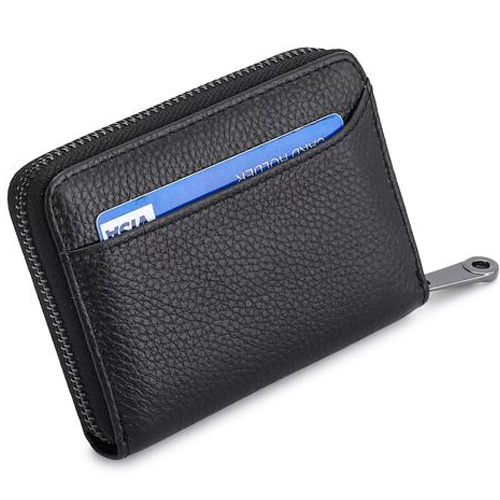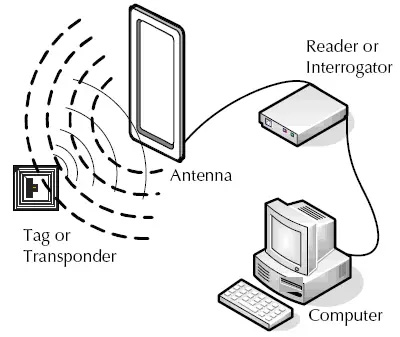
RFID wallets are designed to utilize RFID technology primarily for protecting items with RFID chips, such as credit cards and ID cards. RFID technology transmits data through electromagnetic fields using radio frequencies, allowing for identification and tracking without physical contact. While this convenience makes payments and identity verification highly efficient, it also poses a risk of wireless theft. Therefore, the best RFID wallets are specifically designed to provide protection and ensure the security of personal information.
RFID wallets are not just a stylish accessory; they are also an important tool for protecting personal privacy. With the rise in identity theft and credit card cloning incidents, RFID wallets have been specifically designed to resist external signals and ensure the security of user information. They not only accommodate cash and cards but also feature powerful shielding capabilities to prevent data theft.
The outer layer of these wallets is typically made from leather or fabric, while the inner layer is coated with metallic nano materials, providing excellent penetration resistance. The materials used in RFID wallets undergo special processing to ensure they remain soft and safe for everyday use, making them an ideal choice for high-end users looking to protect their personal privacy.

The operation of RFID wallets primarily relies on Radio Frequency Identification (RFID) technology. Here’s a basic overview of how it works:
RFID Chip and Antenna
RFID Chip: A small RFID chip is embedded inside the wallet to store card information.
Antenna: The RFID chip is typically connected to an antenna, allowing it to receive and transmit wireless signals.
RFID Reader
Signal Emission: When the RFID wallet is near an RFID reader (such as a payment terminal or access control system), the reader emits an electromagnetic signal.
Signal Reception: The antenna in the RFID wallet picks up this signal and activates the RFID chip.
Data Transmission
Information Transfer: The RFID chip uses the antenna to send stored information (such as card numbers or identification data) back to the reader.
Contactless Identification: This entire process occurs without physical contact, typically at a distance of a few centimeters.
Security Protection
Shielding Materials: RFID wallets often use special shielding materials to prevent unauthorized readers from accessing information, thus protecting the user’s personal data from theft.
This technology is utilized in many fields, including military applications, commercial aviation, keyless entry for vehicles, electronic tagging, passports, laptops, mobile phones, and credit cards.
1. Security Protection: RFID wallets use shielding materials to block unauthorized scanning, protecting personal information and financial data.
2. Compact Design: Typically designed to be slim and lightweight, making them easy to carry while accommodating multiple cards.
3. Durable Materials: Often made from high-quality leather or synthetic materials, ensuring long-lasting use.
4. Multi-functionality: Many RFID wallets come with additional features such as waterproofing, RFID shielding, and built-in coin compartments.
5. Stylish Appearance: Available in various designs and colors, combining functionality with aesthetics.
6. Compatibility: Works with most RFID-enabled cards, suitable for various payment and identification needs.
The blocking functionality of RFID-blocking wallets primarily stems from the special materials they use, including conductive metals and RFID shielding fabrics. RFID (Radio Frequency Identification) technology powers small chips via electromagnetic fields, allowing them to emit response signals; it is commonly used in credit cards and access cards. To prevent these chips from being activated by unauthorized readers, RFID wallets feature card slots or entire wallets made from materials that block radio waves.
These wallets incorporate metallic nano materials or conductive substances that create an electromagnetic shielding layer, effectively preventing electromagnetic waves from penetrating and protecting the internal information. Additionally, RFID shielding fabrics offer benefits such as radiation protection, demagnetization, anti-theft, and scanning prevention. When items with RFID chips are placed inside an RFID-blocking wallet, the wireless signals are blocked, shielding against electromagnetic interference. This prevents electronic pickpockets from scanning bank card information from a distance, thus safeguarding personal privacy and financial security.
The multi-layer design of these wallets typically features an outer layer made from leather or fabric, while the inner layer contains shielding materials, ensuring both security and aesthetic appeal.
Yes, RFID wallets can be tracked, but this requires the use of additional technologies or devices.
RFID technology primarily facilitates data transmission through radio waves, enabling non-contact identification between tags and readers. Traditionally, RFID is used for identification rather than precise location tracking. Its main function is to identify the identity of objects or individuals rather than providing direct location services. However, with the integration of certain technologies and devices, RFID wallets can achieve tracking capabilities.
1. Coordinated Multiple Readers: Deploying multiple RFID readers within a specific area creates a network coverage. When an object with an RFID tag enters this area, several readers receive the tag's signal simultaneously. By comparing parameters such as signal strength and phase differences from different readers, the approximate location of the tag can be estimated.
2. Signal Processing Techniques: Utilizing techniques like Time Difference of Arrival (TDOA) and Angle of Arrival (AOA) can further enhance the accuracy of RFID location tracking. These methods enable more precise capture and analysis of signal characteristics, leading to more accurate location information.
3. Integrated Positioning Technologies: Combining RFID with other positioning technologies (such as Wi-Fi, Bluetooth, or UWB) leverages complementary advantages. By integrating data from multiple sources, the accuracy and stability of location tracking can be significantly improved, catering to more complex tracking needs.
Privacy and Security Issues in small RFID Wallet Tracking: When using RFID wallets for tracking, privacy and security considerations are essential. Employing encryption techniques and anonymization can protect user privacy while ensuring location accuracy. Additionally, proper permission settings and access control mechanisms are crucial measures for safeguarding data security.
RFID wallets typically pass through airport security without issues. Security checks focus on the safety of items rather than the type of wallet. However, it’s advisable to remove your wallet and place it in the tray for clear inspection by security personnel. To avoid any complications, it’s best to follow the airport security regulations and instructions.
Here are a few points to consider when using an RFID wallet at airport security:
1. Impact of Security Equipment on RFID Wallets: Airport security equipment mainly consists of metal detectors and X-ray machines, which do not affect RFID wallets. RFID technology communicates via radio waves, while security devices use electromagnetic waves, so they do not interfere with each other.
2. Materials and Functionality of RFID Wallets: RFID wallets are often made from metal or other conductive materials, but these materials do not disrupt the normal operation of security equipment. The primary function of RFID wallets is to transmit data via radio waves, which is different from how security equipment operates.
3. Considerations When Using RFID Wallets: While RFID wallets can go through security, they may trigger false alarms when passing through metal detectors. Additionally, to protect your privacy, it’s advisable not to store sensitive information on tags or to take appropriate protective measures when using an RFID wallet.
RFID wallets do not interfere with mobile phones. RFID technology and mobile communication use different frequencies and protocols, so they typically do not affect each other.
Additionally, RFID wallets are made from magnetic-proof materials that block wireless signals and shield against electromagnetic interference. When items with RFID chips are placed inside the wallet, the wireless signals are blocked, preventing electronic pickpockets from scanning card information from a distance, thus protecting personal information and financial security. Moreover, RFID wallets feature excellent protection against radiation, demagnetization, unauthorized scanning, and theft, making them highly effective for safeguarding personal belongings and information.
Chipbond Technology is a professional RFID card wallet manufacturer with its own factory and multiple production lines to ensure product quality and production efficiency. With 28 years of manufacturing experience, we are able to offer affordable prices and fast delivery times. In addition, we have an excellent pre-sales and after-sales service team dedicated to providing one-stop purchasing service for our customers. If you have any requirements, please feel free to contact us info@chipbond.com